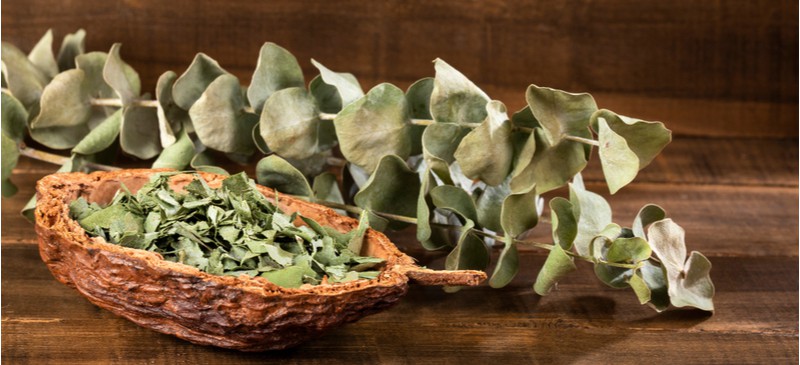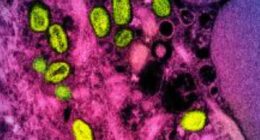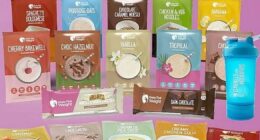
You may already know that eucalyptus oil is recommended for treating a variety of respiratory symptoms due to its natural decongestant effects and antiseptic properties — but did you know that eucalyptus leaves themselves can also be utilized in similar ways?
The aboriginal people of Australia, as well as early European explorers and collectors, have used eucalyptus for centuries. Nearly all parts of the plant have medicinal benefit, including the oily leaves, bark and roots.
Concentrated, therapeutic essential oil can be derived from the plant (and taken internally or mixed with a carrier oil before being applies to the skin), while the leaves can be dried to make tinctures, steeped to make tea or steamed to create beneficial vapors.
While you want to avoid munching on raw eucalyptus leaves since they can be very hard to digest, preparing the leaves in other ways helps release their protective compounds.
Using eucalyptus herbal infusions and tonics, you can prepare DIY flu and cold remedies to help treat symptoms like congestion, coughs and more. You also apply some to your skin and mouth to promote healing.
What Are Eucalyptus Leaves?
Eucalyptus leaves come from eucalyptus plants (most often Eucalyptus globulus), which are actually hundreds of related species in the myrtle (Myrtaceae) plant family that are mostly native to Australia.
These leaves are covered with oil glands and have a natural menthol scent, similar to mint leaves. They contain a number of beneficial compounds found mostly within the plant’s volatile essential oils.
Eucalyptus species grow as trees, shrubs or house plants (indoor and outdoor) depending on the specific type and the climate. The leaves usually start out as light green ovals and become darker green as the plant matures.
Most types are evergreens and hold on to their leaves year-round.
Some popular eucalyptus leaves uses include:
- Soothing symptoms of colds and the flu
- Boosting skin health when added to massage oils and bath additives
- Soothing congestion when consumed as a tea
- Adding a fresh, menthol scent to your home when used in aromatherapy
Benefits
Due to the presence of compounds including cineole and flavonoid antioxidants found within eucalyptus leaves, they have been found to have antibacterial, antiseptic and expectorant properties. Below are some of the main benefits and uses of these leaves.
1. High in Antioxidants and Antimicrobial Compounds
These leaves are packed with protective terpenes, flavonoids and other antioxidants, including:
- eucalyptol (also called cineole)
- catechins
- quercetin
- isorhamnetin
- luteolin
- limolene
- kaempferol
- phloretin
These compounds can generally help fight oxidative stress and support the immune system due to their anti-inflammatory effects. They may also have pain-killing properties and can potentially help reduce joint pain when applied to topically.
Cineole is an especially valuable compound present in these leaves that has been shown in studies to have antimicrobial effects against many bacteria, including Mycobacterium tuberculosis and methicillin-resistant Staphylococcus aureus (MRSA) — as well as viruses and fungi (including candida).
2. Help Loosen Phlegm and Coughs
According to research studies, eucalyptus makes a great natural treatment for common respiratory issues, including:
- coughs
- sore throats
- phlegm, nasal congestion and mucus buildup
- respiratory infections
- bronchitis
- headaches due to sinus pressure
- asthma symptoms
- symptoms tied to chronic obstructive pulmonary disease (COPD)
An added benefit of inhaling this plant’s scent is that it can help promote relaxation and reduce anxiety and blood pressure.
To get these benefits, the leaves can be steamed and inhaled or made into a topical treatment that can be applied to the chest.
3. May Help Manage Asthma Symptoms
One particular terpene compound found in these leaves, called cineole/eucalyptol, has been shown in some studies to help improve asthma symptoms. In one study, 600 milligrams of eucalyptol per day was compared to a placebo among adults with asthma over the course of 12 weeks.
The group taking eucalyptol experienced a decreased need for steroid medications used to control symptoms, significantly more so than the placebo group.
Researchers involved in the study credit cineole’s anti-inflamamtory effects with the observed improvements in asthma symptoms. It’s been found that cineole can suppress arachidonic acid metabolism and cytokine production, two factors that may lead to severe asthma.
READ RELATED: Ashitaba: A Traditional Leafy Green with an Impressive Nutrition Profile
4. Support Skin Health and Reduce Dryness
Eucalyptus leaf can be used to make an extract that has healing effects when applied to dry or sensitive skin. Some studies have demonstrated that it can increase ceramide production in the skin, which increase moisture and creates a protective barrier that decreases dryness, redness, itchiness and scaliness.
Researchers believe it has this effect due to compounds including macrocarpal A.
One study found that topical application of eucalyptus extract-containing lotion to participants’ dry and scaly scalps helped improve quality of life and symptoms associated with atopic dermatitis, seborrheic dermatitis or pityriasis capitis.
5. Promote Dental Health
In addition to soothing damaged skin, eucalyptus leaf can aid in periodontal health by cleansing the inside of the mouth. It’s sometimes added to mouthwashes and gums to help prevent plaque buildup, clean the gums and reduce bleeding, and help control inflammation and bacteria growth that may contribute to gum disease.
How to Use
Eucalyptus leaf is found in a wide variety of products, including cough drops, beauty products, herbal teas, candles and potpourri.
To make your own eucalyptus salves, cough drops and other remedies, you can first create a tincture or “herbal infusion” by steeping the leaves.
- Herbal Infusion— An herbal infusion is like “a cup of tea without the tea leaves.” It’s basically a liquid that contains the nutrients released from herbs once they are steeped/soaked. To make one using eucalyptus, add a handful of fresh leaves to hot water in a glass jar, and let it sit for about eight hours. Then remove the leaves, and drink the water. You can also use liquid on your skin to help soothe irritation and for its cleansing effects.
- Tincture — To make a tincture, put a half pound or so of fresh leaves into a large jar and cover with vodka. Seal the jar, and leave it for two weeks, then strain. Store the tincture in a sealed jar in a cool, dry area. It should stay good for several months.
- Herbal Tea — Another way to use fresh leaves is by brewing them to make herbal tea, which is great to sip on if you feel congested. Add several fresh leaves or half a teaspoon of crushed dried leaves to very hot water, and let it steep for several minutes. Then take out the leaves, and drink it once it’s cooled a bit.
Here are some other DIY recipes you can make at home using these leaves:
- Herbal Chest Rub — Combine eucalyptus tincture with beeswax, and spread over your chest to help decrease congestion.
- Massage Oil and Skin Salve — Add eucalyptus tincture to a carrier oil with calendula, and massage over dry patches of skin. (Just avoid putting it on open wounds.) You can also make a massage oil to help decrease joint pain, swelling and arthritis. Fill a glass jar with a handful of fresh or dried leaves, then cover with olive, coconut, jojoba or sweet almond oil. Place the oil in direct sun for two weeks, and then strain and apply to the skin.
- Homemade Cough Drops — Freeze eucalyptus tea or herbal infusion using a cough drop tray or an ice tray. (You’ll want to chop the ice cubes into smaller pieces if you do this.)
How do I dry the leaves?
You can dry the leaves on the stem by hanging the branches upside down in a dry place in your home. An alternative is to remove the leaves from the stem and dry them on your counter on a paper towel.
You’ll know the leaves are dried once they have a crispy or “leathery” appearance. Store them in a glass jar to keep them fresh.
Can I boil eucalyptus leaves and drink it?
Yes, you can turn the fresh leaves into tea or use them to make tinctures. See above for directions.
How can you use eucalyptus leaves in the shower?
Hang the leaves on their stem in your shower, or add them to your bath. The steam will help release the beneficial compounds.
You can also add some to a bowl with warm water and inhale the steam/vapors coming off. If using the bowl method, consider placing a damp towel over the top of your head to help keep the steam near your face.
Where do you find eucalyptus leaves?
In terms of where to buy eucalyptus leaves, look in health food stores, some gardening stores or online. You can also easily grow this plant yourself at home (see below), whether indoors and outdoors.
How long do eucalyptus leaves last?
Fresh leaves should be used within about three to eight weeks. Dried, preserved leaves last for as long as one to two years if stored in a well-sealed container.
How to Grow
Eucalyptus can be grown at home as a potted shrub or indoor/outdoor plant, depending on the specific species. It grows best in temperate or cool climates outdoors and should be brought inside when the temperature gets very cold.
These plants are considered “heavy feeders” and need lots of sun exposure. They grow well in a variety of soils as long as they are fed often and receive lots of sunlight.
Risks and Side Effects
Is eucalyptus leaf poisonous? It’s important not to consume eucalyptus essential oil internally or to eat the raw leaves.
Eucalyptus leaf can potentially be toxic and result in side effects, including nausea, vomiting, diarrhea and even neurological changes.
Avoid consuming even small amounts of the leaves, instead preparing them via steeping or steaming first.
Conclusion
- Eucalyptus leaf is high in beneficial compounds, including terpenes, cineole/eucalyptol, as well as flavonoids and other antioxidants that have been found to support respiratory health.
- Benefits of consuming these leaves can include decreasing congestion and coughs, reduced sore throat pain, less sinus headaches, and decreased asthma symptoms. Other uses include soothing dry or irritated skin and preventing plaque buildup on teeth and signs of gum disease.
- Wondering what to do with dried eucalyptus leaves? You can use either fresh or dried leaves in DIY recipes, such as teas, herbal infusions, tinctures, cough drops and skin salves.
- Do not eat the leaves themselves or ingest eucalyptus essential oil, because this can potentially lead to dangerous side effects.
Source: Dr. Axe | Nutrition






